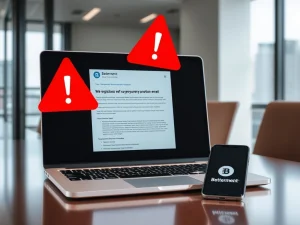Shocking Truth: US Banks Laundered $312 Billion, Yet Crypto Still Faces Misguided Blame

Recent revelations challenge common narratives about illicit finance. A new report by the US Financial Crimes Enforcement Network (FinCEN) exposes the staggering scale of US banks money laundering, moving hundreds of billions in dirty money. This significant finding comes despite ongoing criticism and focus on crypto illicit activity from lawmakers. For those deeply invested in the cryptocurrency space, understanding the true landscape of global financial crime is crucial for informed discussions and balanced regulatory approaches.
FinCEN Report Unmasks Massive Traditional Financial Crime
A comprehensive advisory from the US Financial Crimes Enforcement Network (FinCEN) has unveiled alarming figures. Between 2020 and 2024, US financial institutions facilitated the laundering of an astonishing $312 billion. This vast sum moved through traditional banking channels, implicating established financial systems in large-scale illicit operations. Specifically, the FinCEN report, released on Thursday, analyzed over 137,000 Bank Secrecy Act filings. These documents clearly indicated that an average of more than $62 billion per year flowed through the US banking system. This money originated from sophisticated Chinese money laundering networks.
These networks have forged a troubling alliance with Mexico-based drug cartels. The cartels, needing to clean their US dollar drug proceeds, found willing partners. Simultaneously, Chinese gangs sought US dollars to circumvent China’s strict currency control laws. Andrea Gacki, FinCEN Director, emphasized the gravity of the situation. She stated, “These networks launder proceeds for Mexico-based drug cartels and are involved in other significant, underground money movement schemes within the United States and around the world.” Therefore, the problem extends far beyond simple drug money. Additionally, the report highlighted the involvement of Chinese gangs in human trafficking, smuggling operations, healthcare fraud, and elder abuse. They also played a role in real estate money laundering, accounting for $53.7 billion in suspicious transactions. This paints a grim picture of widespread criminal enterprise leveraging traditional finance.
The Disproportionate Focus on Crypto Illicit Activity
Despite these colossal figures from the traditional banking sector, the cryptocurrency industry frequently bears the brunt of accusations regarding illicit finance. Prominent politicians, like Senator Elizabeth Warren, ranking member of the Senate Banking Committee, often single out crypto. Earlier this year, she asserted, “Bad actors are also increasingly turning to cryptocurrency to enable money laundering,” advocating for tougher regulations. However, the latest money laundering statistics present a stark contrast to this narrative. They reveal an often-ignored reality: the vast majority of money laundering occurs outside the crypto sphere. This ongoing criticism, therefore, seems disproportionate when viewed against the backdrop of traditional financial crime.
Consider the broader context of global illicit finance. The United Nations Office on Drugs and Crime estimates that over $2 trillion is laundered globally each year. In comparison, the entire cryptocurrency ecosystem saw approximately $189 billion in illicit crypto volumes over the past five years, according to Chainalysis. This figure represents a tiny fraction of the overall illicit financial landscape. Angela Ang, head of policy and strategic partnerships at TRM Labs, further clarified this point. She told Crypto News Insights, “Illicit activity is but a small fraction of the crypto ecosystem. We estimate that it is less than 1% of overall crypto volume.” This perspective underscores that while challenges exist, the scale of crypto illicit activity is significantly smaller than often portrayed.
Source: Nate Geraci
Traditional Channels Remain Primary for Financial Crime
The FinCEN findings align with a broader, well-established pattern. These underground banking networks effectively operate as a shadow financial system for organized crime globally. They exploit the seams and vulnerabilities within established banking systems. Angela Ang of TRM Labs noted, “FinCEN’s findings align with a broader pattern – these underground banking networks function as a shadow financial system for organized crime worldwide, operating at the seams of banking systems.” Consequently, cash and traditional banking systems remain the dominant conduits for illicit funds. The sheer volume of money laundered through these conventional methods dwarfs the amounts associated with cryptocurrency.
Source: Zigram
This reality necessitates a re-evaluation of regulatory priorities. Focusing excessively on crypto, while ignoring the massive scale of US banks money laundering, risks misallocating resources. A balanced approach would acknowledge that financial crime is a complex, multifaceted issue. It pervades all financial systems, both traditional and nascent. Therefore, effective strategies must target the largest and most impactful channels of illicit activity, regardless of the technology used. Regulators and policymakers must consider comprehensive data rather than relying on sensationalized or politically convenient narratives. Ultimately, a clear understanding of where the vast majority of illicit funds move is essential for developing truly effective anti-money laundering measures. This ensures that efforts are directed towards the most significant threats to financial integrity.
Moving Forward: A Balanced View on Illicit Finance
The recent FinCEN report offers a critical perspective. It highlights the immense scale of money laundering within traditional banking systems. This report serves as a powerful reminder that while crypto illicit activity certainly exists, its scope is considerably smaller than that facilitated by conventional finance. Therefore, lawmakers and the public should adopt a more nuanced understanding. Instead of solely blaming emerging technologies, attention must shift towards the systemic vulnerabilities present in all financial channels. The pursuit of robust anti-money laundering frameworks should be data-driven and proportionate.
For the cryptocurrency community, these findings reinforce the need for continued transparency and collaboration with regulators. By proactively addressing legitimate concerns, the industry can further distinguish itself from the true epicenters of financial crime. This also allows for a more constructive dialogue about the benefits and risks of digital assets. Ultimately, achieving a secure and compliant global financial system requires addressing the largest sources of illicit funds. This means focusing on comprehensive solutions that target all forms of money laundering, rather than singling out specific technologies based on outdated perceptions. The evidence is clear: the scale of money laundering statistics from traditional banks demands serious attention.









